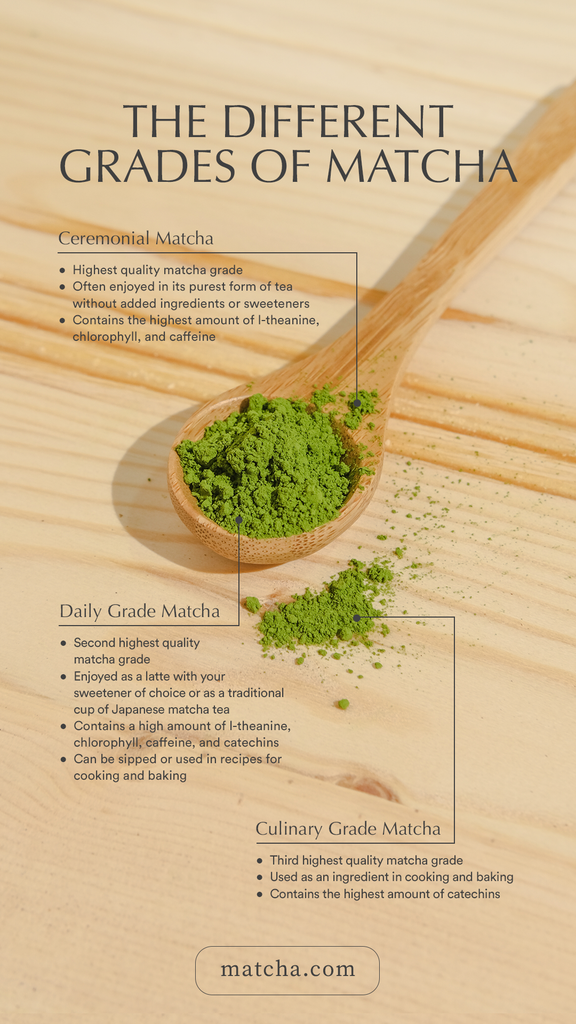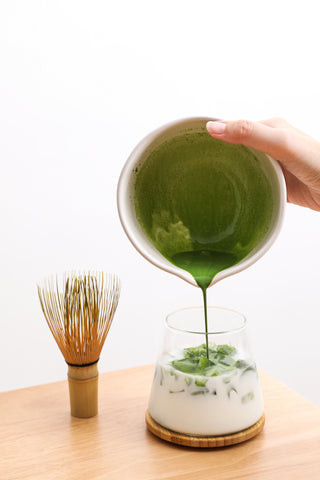If you've considered buying and preparing matcha at home, you've likely realized not all matcha powders are created equal – and this is intentional! There are actually a range of different types of matcha green tea powders available.
All the different grades of matcha have varying flavor profiles, colors, textures, and uses.
Taking the time to educate and familiarize yourself with the different grades of matcha and their unique properties will help you find the best match(a), depending on how you plan to enjoy and use it.

The different grades of matcha green tea powder
There are three main grades of matcha – ceremonial, daily, and culinary. Matcha green tea powder is placed into one of these three categories based on where the green tea plants are grown, how they are cultivated, the tea leaves's harvest period (or season), and the manufacturing process.
These factors, in turn, impact color, texture, nutritional composition, taste, ultimate use, and the overall quality of green tea powder produced.
The three primary grades of matcha can also be further separated into more specific categories such as organic ceremonial matcha, premium daily sipping matcha, cafe barista matcha, chef's choice matcha, and food ingredient grade matcha.
Learn more about what matcha is and what it tastes like.
Ceremonial Grade Matcha:
Hand-picked and made from the youngest first-harvest green tea leaves, ceremonial grade matcha is considered the highest quality matcha available. It is the grade of matcha chosen for traditional Japanese tea ceremonies.
Delicately stone-ground into a fine powder, ceremonial matcha has a vibrant green color, fresh, sweet, earthy smell, silky smooth texture, and a complex vegetal sweet and umami flavor that leaves a creamy, delicate aftertaste on the tongue.
It also has a noticeably deeper shade of green compared to the other two grades of matcha due to its exceptionally high chlorophyll content.

When it comes to enjoying ceremonial-grade matcha, it is often reserved for sipping in its purest form – whisked in a bowl with water without additional sweeteners or milk.
Some people also find that ceremonial grade is a wonderful matcha to use in their matcha latte recipes.
It can also be used for baking, but proceed with caution – ceremonial grade matcha has such a gentle and delicate flavor profile that it can be lost and underwhelming in recipes. It is often the priciest matcha, so it doesn't usually make for the ideal bulk baking or cooking ingredient.
Matcha.com has several different types of ceremonial grade matcha green tea powders:
- Tenchi Ceremonial Organic
- Organic Matcha Superior
- Original Ceremonial Grade Matcha
- Japanese Ceremonial Organic Matcha – USDA Organic Shade-grown Matcha
- Premium Ceremonial Master's Blend Matcha
- Ceremonial Flavored Organic Matcha
- Daily Ritual Ceremonial Matcha
Daily Grade Matcha:
Also known as premium and traditional grade matcha, daily matcha is not too sweet or bitter — falling right between ceremonial and culinary matcha as the second highest quality grade of green tea powder.
Daily matcha often has a richly balanced taste, clean and crisp aroma, smooth texture, and luminescent, joyful green color. It can be enjoyed on its own and pairs beautifully with milk, water, and sweeteners — making daily matcha an ideal grade for those looking for a dynamic matcha powder prepared in various ways.
It's also great for matcha newcomers.

Often from a combination of the first and second harvest or just the second harvest of young green tea leaves, daily matcha has a slightly bolder taste than ceremonial grades of matcha. This makes the daily matcha grade a favorite choice for matcha lattes, cocktails, and other beverage recipes.
It's also an excellent choice to enjoy 2-3 times a day since it's less expensive than ceremonial grade matcha, has a lower caffeine content, and still packs incredible flavor and supportive health benefits.

Matcha.com has several different types of daily matcha green tea powders:
Culinary Grade Matcha:
Also often known as cooking grade matcha, kitchen, or chef's choice matcha, culinary grade matcha is intended to be used as an ingredient in cooking, beverages, baking, and supplements. It often has a savory edge and robust flavor profile.
As the third highest quality matcha grade, culinary matcha is a perfect choice for sweet and savory matcha recipes.
Culinary matcha often comes from older green tea leaves than those chosen for ceremonial or daily matcha – often from the second, third or even fourth harvest. This means the young green tea leaves used to make culinary matcha are exposed to more sunlight, which boosts the catechins' levels.

The higher amount of catechins in culinary matcha impacts its flavor profile, giving it a more astringent, bold flavor with a bitter aftertaste and less sugary-sweet essence that shines through beautifully in baking and cooking.
You may notice your culinary grade matcha is not a vibrant, bright green color like your daily or ceremonial matcha – instead, it takes on a more subdued shade of green.
It's also stone-ground for a shorter period at a rapid rate, which gives culinary matcha a larger particle size that results in a grainier, gritty texture that pairs well with recipes.
There is a common misconception that culinary grade matcha is a low-grade form of matcha – but that's not actually true. It's specifically cultivated, harvested, and prepared for cooking and baking.
Try the finger test to assess the quality of your matcha powder
To asses the quality of your matcha, you can use the finger test. Put a little matcha powder on a piece of white paper and then press your finger into it and precede to press, drag, and draw a line with it using your finger. Higher quality grades of matcha will be smoother and create a more solid, longer line than lower grade matcha.
How do you compare different matcha powders and their quality?
Do the finger test with multiple matcha powders on the same piece of paper for a comparison!
Place your various matcha powders in small piles onto a piece of paper and draw a line in each of them using your finger, wiping it between each one. The higher quality matcha will be smoother, creating more solid, longer lines than the lower grade matcha powders.
Matcha.com has several different types of culinary grade matcha green tea powders:
Which grade of matcha is better for your health?
All three grades of matcha have a similar baseline nutrient profile, though ceremonial grade matcha – produced from first-harvest leaves – has a much higher amount of l-theanine and caffeine content.
Meanwhile, daily and culinary grade matcha – made from later harvest leaves – is often the highest in antioxidants and catechins.
You can learn more about matcha's dynamic range of supportive health benefits here.
How do choose which matcha grade is best for you?
To know what matcha tea or different green tea powder you should buy, asking yourself a few questions can be helpful.
For example, do you plan on drinking a traditional cup of Japanese matcha tea every morning as a daily ritual? Do you enjoy matcha lattes and adding a sweetener to your caffeine or energy beverage?
Do you plan to experiment in the kitchen by adding matcha to different baking recipes or your morning smoothies? Or maybe you plan on doing all of the above and more with your matcha powder!
You may also like:
- How to tell if your matcha has gone bad
- Wholesale and bulk matcha grades
- How to quickly prepare matcha in large batches as a barista
- The difference between matcha and green tea
- Japanese vs. Chinese grown matcha
The bottom line
We want to leave you with one final disclaimer regarding different grades of matcha: There is so much more to consider when assessing the grade and quality of matcha than just color. Much like grapes cultivated for different types of wine, matcha green tea powder has a range of quality levels, each accompanied by a corresponding scope of prices.
Instead, the quality of matcha hinges on several factors we've touched on, such as its place of origin, cultivation methods, harvest timing, and processing techniques. Also, remember that the classification of matcha grades varies from brand to brand.
At Matcha.com, we take immense pride in making high-quality matcha available around the globe that spans various grades, including our later harvest selections. All of our matcha is organically sourced with traditional matcha farms in Uji, Kyoto, Japan with the highest standards.
Now it's time to browse the options and try different grades and types of matcha you think will work best for you!
Disclaimer: These statements in this blog post have not been evaluated by the Food and Drug Administration. The information provided here is for educational purposes only and should not be considered as medical advice. It's essential to consult with a qualified healthcare professional before making any dietary or lifestyle changes







